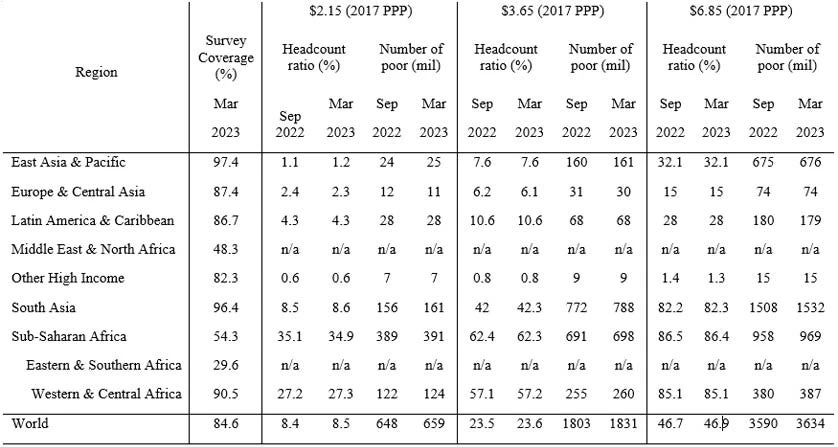Global poverty estimates were updated today on the Poverty and Inequality Platform (PIP). This update includes new regional poverty aggregates in 2020 and 2021 for Latin America and the Caribbean, and in 2020 for Europe and Central Asia, and the group of advanced countries. These are the regions for which we now have sufficient survey data available during the COVID-19 pandemic. In total, 113 new country-years have been added, bringing the total number of surveys to more than 2,100.
This update also incorporates the usual changes to the input data, including revisions to existing welfare distributions, the inclusion of new welfare distributions, and revisions to price, national accounts, and population data used for global poverty monitoring (more details here). Overall, these changes have resulted in minor revisions in global and regional poverty estimates.
Table 1 summarizes the revisions to the regional and global poverty estimates between the September 2022 data vintage and the March 2023 data vintage for the 2019 reference year at all three poverty lines. The global poverty headcount ratio at $2.15 is revised slightly up by 0.1 percentage points to 8.5 percent, resulting in a revision in the number of poor people from 648 to 659 million. This revision represents 11 million more people living in extreme poverty, largely driven by South Asia (5 million) and the Middle East and North Africa (4 million).
Table 1 Poverty estimates for reference year 2019, changes between September 2022 and March 2023 vintage by region and poverty lines

Similar limited changes in poverty estimates are observed at the higher lines of $3.65 and $6.85, which are typically used for measuring poverty in lower-middle- and upper-middle-income countries, respectively. At $3.65, the global poverty headcount ratio increases by 0.1 percentage points to 23.6 percent, representing 28 million more people living in poverty. At $6.85, the global poverty rate increases by 0.2 percentage points to 46.9 percent, representing 44 million people living in poverty. The upward revisions in poverty estimates at the higher lines are largely driven by South Asia and Sub-Saharan Africa.
This March 2023 global poverty update from the World Bank revises the previously published global and regional estimates from 1981 to 2019. Regional poverty estimates are now reported up to 2021, depending on sufficient data coverage over the period of the COVID-19 pandemic. Poverty data are reported for Europe and Central Asia until 2020, and Latin America and the Caribbean until 2021. For all other developing regions, poverty data are reported for pre-pandemic years (see Figure 1). More details are available here on how we have determined those regions for which to report post-2019 estimates.
Figure 1: Global and regional poverty estimates, 1990 - 2021
The data published in this PIP update, while incorporating more recent input data, do not change the overall perceptions about global poverty trends and the regional distribution of poverty. It is still the case that global poverty has been falling since the 1990s, and at a slower rate since 2014 (World Bank 2022). Extreme poverty has been falling in all regions, except the Middle East and North Africa due to conflict and fragility (World Bank 2020). Roughly 60% of the world’s extreme poor in 2019 lived in Sub-Saharan Africa alone, while 81% of the global poor at the poverty line of $3.65 lived in Sub-Saharan Africa or South Asia.
The authors gratefully acknowledge financial support from the UK Government through the Data and Evidence for Tackling Extreme Poverty (DEEP) Research Program.








Join the Conversation